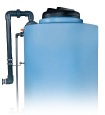The day you receive your SAFE-Tank chemical storage system is the most critical day in the life of your tank. Safe and proper installation isn’t difficult, but you have to pay attention. An improper installation can mean expensive or time-consuming problems down the road.
Topics:
Installation and Field Service,
Fittings and Accessories,
Chemical Storage
Poly Processing Company is committed to making your experience with us as simple and effective as possible. To help save time and eliminate frustration, we’ve created an app for selecting the right chemical storage tank, called the PPC Tank Selector Tool.
Topics:
Technology Tips
If you’ve recently purchased a new polyethylene chemical storage tank or are planning on purchasing a poly tank, there are several ways to protect your storage solution from the start.
Topics:
Installation and Field Service,
Value Added
Power plants rely on several important chemicals to generate energy and operate at peak efficiency. The most sensitive application areas are cooling and boiler water treatment, since a failure in either of these areas directly impacts the facility’s operations.
Topics:
Chemical Storage,
Power Plants
Liquid glues, or white glues, are water-based adhesives that are used in a wide variety of applications. They’re popular, because they are eco-friendly, non-toxic, easily recyclable, and safe to handle.
Topics:
Chemicals
Poly Processing tanks are used worldwide for water and wastewater treatment applications. We provide solutions to a wide variety of businesses and organizations that use tanks to store chemicals and other materials for water treatment.
Topics:
Fittings and Accessories,
Chemical Storage
Chemical storage tanks aren’t just for wastewater treatment plants. Poly Processing tanks are found in dozens of industries nationwide, from agriculture to manufacturing to pharmaceuticals and beyond. We work with almost any business that uses chemicals to design and manufacture the right storage tank system for each specific application.
Topics:
Fittings and Accessories,
Chemical Storage
We’re obsessive about designing the proper tank for your particular chemical storage needs. But the right tank for the right job doesn’t matter if it isn’t offloaded and installed properly.
Topics:
Installation and Field Service,
Chemical Storage
The oil and gas industry is one of the largest revenue sectors in the world, generating over $3 trillion each year. The United States is one of the top producers of oil, making it a critical industry to the country’s economy. Oilfields depend upon chemical solutions to ensure they continue steady oil production — especially as the oilfields age.
Topics:
Fittings and Accessories,
Chemical Storage
Chemical storage tanks aren’t just for wastewater treatment plants. Poly Processing tanks are found in dozens of industries nationwide, from agriculture to manufacturing to pharmaceuticals and beyond. We work with almost any business that uses chemicals. We design and manufacture the right storage tank system for your specific application.
Topics:
Fittings and Accessories,
Chemical Storage



